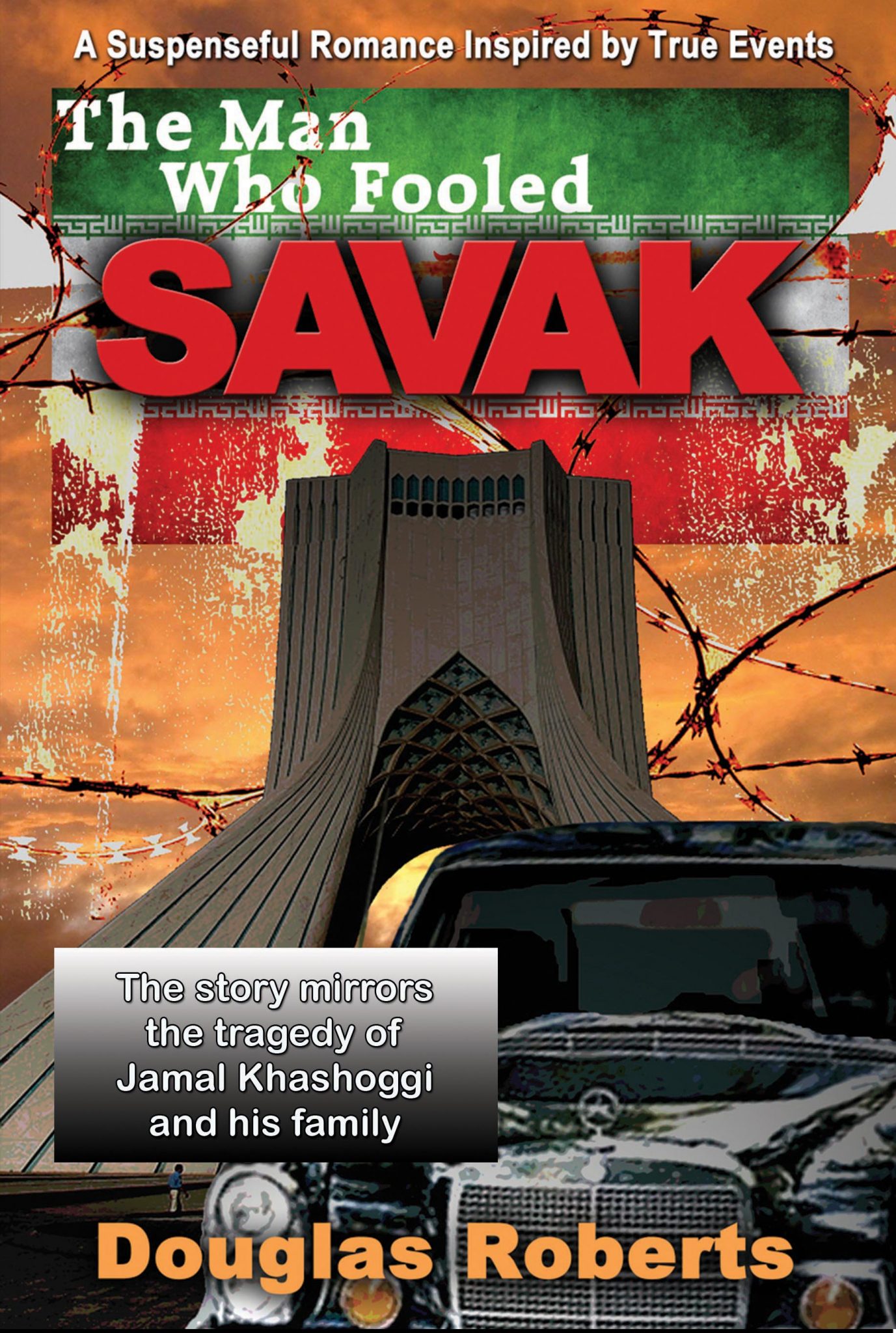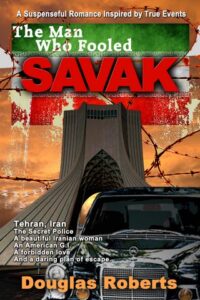


Inspired by true events in the early 1970s, The Man Who Fooled SAVAK captures what it is like to live in a dictatorship with secret police monitoring your every move – an atmosphere of fear that still pervades today in many countries in the Middle East.
Order your copy at a special publisher’s discount price of $12.99, list is $15.99.
Just click on our Bookstore tab and then click on Fiction.
We decided to reprint this interview with Douglas Roberts about what inspired him to write such a book. The interview was originally published June 19, 2011.
_______________________________________
 When Doug Roberts approached us with his manuscript, The Man Who Fooled SAVAK, it was one of those stories that completely engrossed you where you couldn’t put it down until it was finished.
When Doug Roberts approached us with his manuscript, The Man Who Fooled SAVAK, it was one of those stories that completely engrossed you where you couldn’t put it down until it was finished.
Inspired by true events in the early 1970s, The Man Who Fooled SAVAK captures what it is like to live in a dictatorship with secret police monitoring your every move – an atmosphere of fear that still pervades today in many countries in the Middle East.
What makes Doug’s book so appealing is that what he wrote today about events 40 years ago is still going on today in many parts of the Middle East. And all of these events are carefully woven into a love story that will make you fall in love all over again.
Q. The release of your book coincides rather well with Arab Spring. When did you start writing it?
A. In the summer of 2008. A woman I’d met on line named Erica Murray was interested in Iran so I started writing to her about it. I started doing some very preliminary research into the history and politics of Iran in 1971 in order to refresh my memory of things I had experienced when I was in Iran during that time. The book was completely finished several months before the uprising in Tunisia.
Q. Even though that was 40 years ago, there are many common elements with what is happening across the Arab world.
A. Yes, especially the fear people experience when living under an autocratic regime is something I hope I have captured, and as the book proceeds, the breaking out of that fear. Perhaps it will give people hope. Just like in my book, the methods used by various dictatorial regimes to maintain control seem to be taken from a common playbook: trample a free and independent press, keep the people fooled, use an iron fist to silence dissent, eliminate fair trials, use torture to extract confessions – the list goes on and on.
Q. But when you wrote the book, you weren’t thinking about that.
A. (laughs) True! I don’t have a crystal ball and the Arab Spring was as big a surprise to me as the rest of the world.
Q. Can I ask you about one of the characters in your book? Was there really a Junior?
A. Yes there was. I think Junior made the story possible to write. We really did sell our liquor and cigarette rations to him. I recently learned from a fellow who served in ARMISH/MAAG just before I arrived that Junior mostly dealt with the domestic workers, the Iranian nationals who worked at the bachelor quarters where we lived.
Q. I’d like to ask you about another character, Mihan Jazani. She is a historical figure, the wife of the Bijan Jazani who founded one of Iran’s guerilla movements. It appears that she’s a friend of yours on Facebook.
 A. (Blushes) Um, well yes…so it would appear. (laughs) Actually, Mihan Jazani doesn’t like Facebook and never uses it. The Facebook account was set up for Mihan by her granddaughter, Aida. Aida and I exchange messages occasionally.
A. (Blushes) Um, well yes…so it would appear. (laughs) Actually, Mihan Jazani doesn’t like Facebook and never uses it. The Facebook account was set up for Mihan by her granddaughter, Aida. Aida and I exchange messages occasionally.
Q. How were you able to remember so much about what happened then? It was 40 years ago after all.
A. I was assisted in several ways. I had some writings I had done about Iran when I was in journalism school at Kent State in 1972. I had a large number of slides that I’d taken when I was there. Those were crucial in reviving old memories. A huge help was finding a 1977 map of Tehran on the (now defunct) Tehran American School website. I was able to use the exact names of places, even street names. The fellow I’d mentioned earlier who told me about Junior had sent me a copy of the ARMISH/MAAG directory, which was very useful. Finally, talking to people I worked with at that time was extremely important, namely Heidi Eftekhar and Barry Silver, who are characters in the story. I obviously couldn’t remember all events specifically, but I found I could generate them as needed by being very specific in my language. I would take seeds of ideas and extrapolate and grow them into full blown events. For example, a certain lecherous officer really did say to Heidi, “I think you’re a woman who needs a lot of loving.” I took that and ran with it. Last, but also important, the Internet was a valuable tool in researching the historical incidents in the book.
Q. So, where does the novel part come in?
A. Some of the human rights related events are novelized, but they’re very accurate in their portrayal of the times. I’ll leave historians to figure all that out. They will have their work cut out for them because I’ve spent a lot of effort weaving the story line into the history of those days.
Q. How close is your character Doug Roberts to the way you actually are?
A. That’s a really good question. (laughs) I had originally intended that Doug the character would be an extreme version of myself. But after having read my book now over and over, I’ve come to see that what’s extreme are the circumstances he’s in. Doug the character is a lot like I was back then: ok in the smarts department, and a little too cocky sometimes. He’s not very romantic or knowledgeable about women, but does all right in spite of himself. (laughs) There’s an element of male fantasy in the book I suppose. In the story, I have two charming female lunch companions in addition to Fari my Iranian girlfriend/fiancée.
Q. But you really were friends with Heidi Eftekhar your co-worker in the story.
A. I still am. Heidi and I communicate regularly by email and her input on the book was immensely helpful. Miss Farou is the fantasy. She actually didn’t like me all that much. (laughs).
Q. I get the impression you had a lot of fun writing your book.
A. It was pretty trippy for me at times. I would totally submerse myself in it. For example, I had written the scene describing how I spent New Year’s Eve in Iran just a couple of weeks after New Year’s Eve in real life. When someone asked me about how I’d spent my New Years, it shocked me as to how much effort I had to put into pulling up what I’d actually done versus what I’d just written. That was a little scary.
Q. What do you think people will get out of your book?
A. I’m sure everyone will get a little something different, but what I’d like for people to take from it is that, like in the story, life may present you with some extreme circumstances. When that happens, keep a level head and your wits about you. Try to see beyond what appears to be happening on the surface. There will always be some good things happening at any given moment. Try to focus on that. To get through your ordeal it’s a good idea to engage all your friends to help you and your faith if you have that. Most important of all: never give up.
The Man Who Fooled SAVAK is available as an ebook on Amazon Kindle and in various ereader formats from Smashwords.com
Outer Banks Publishing Group
ISBN-13: 978-0982993125
ISBN-10: 0982993129
BISAC: Fiction / Espionage